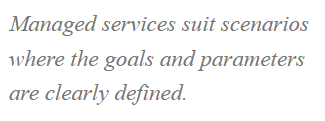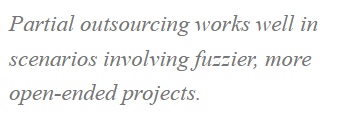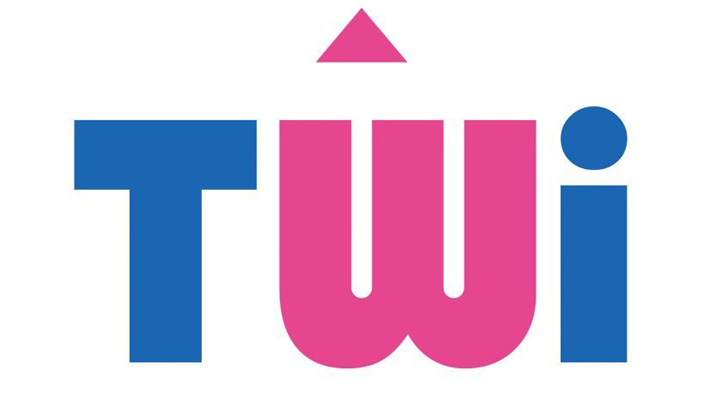Outsourcing is a valuable tool for project managers with limited resources, under pressure to deliver a user manual, training guide, or datasheet. We outline two outsourcing options for delivering high-quality documentation and identify the scenarios with which they are best matched.
Resourcing Challenges
You have documentation requirements that you cannot fulfil with the resources currently at your disposal. Perhaps your information development team is tied up on other projects. Or maybe you don’t have any information developers in-house. Regardless, you are expected to produce a user manual, online help system, installation guide, and/or set of release notes, and publish it in time for a forthcoming product launch. Time is ticking. What are your options?
- You could hire new permanent staff – but you don’t have the budget.
- You could take on some contract staff – but for legal reasons, after a certain length of time you’ll either have to make them permanent or let them go. This keeps you stuck in the frustrating, inefficient cycle of hiring, training, letting go, and rehiring.
- You could engage a freelance information developer – but they lack the availability to provide continuity of service and build a robust relationship with you.
Consequently, you’re not too keen on any of these options.
However, there is another option: outsourcing to a service provider. You may not have considered outsourcing before, and, as a result, you don’t really know what’s involved or what to expect. How does it work? What factors do you need to take into account? Will the quality of the service be to a high standard? How do you decide on the right solution?
This post outlines the following service models, and gives you the tools to assess their suitability for your documentation requirements:
- Managed service solutions
- Partial outsourcing solutions (which can also be referred to as co-sourcing or insourcing)
In some cases, companies decide to completely outsource their technical writing team (full outsourcing rather than partial outsourcing). We won’t address full outsourcing here, as we’re focusing on situations in which you want to support or supplement your existing team.
Getting Started: Asking the Right Questions
Before you can make an informed decision on whether outsourcing is suitable, you need to map out all the relevant requirements and resources. By answering the following questions, you establish a clear picture of the factors involved, based on which you can identify the most appropriate solution:
- What are the project goals?
- Have the project roles been identified and defined? Who are the stakeholders?
- Is sufficient subject matter expert (SME) time available?
- Who is responsible for content production – for example, will the SME produce content directly?
- What is the timeline?
- Is there adequate budget for the project?
- Who is the target audience? What is their level of knowledge and what are their information needs?
- What content management system and authoring tools will be used? What output formats are required?
- What channels of communication will be used? Will there be language barriers or different time zones to consider?
- Is there a template and is it necessary to have one?
- Is there a style guide? Does one need to be created?
- What are the graphic requirements?
- How will documentation quality control be managed?
Click here to download a printable version of these questions as a useful job aid.
Now that you’ve clearly mapped out your requirements and resources, you can use this as the basis to decide which outsourcing option is the best match for your scenario. The following sections explain two common options, and provide examples of the scenarios to which they are most applicable.
Option 1: Managed Service Solutions
 In a managed service, one or more information developers are managed by their own external team lead to deliver your documentation requirements. In this scenario, you are essentially paying for a specific product to be delivered within a given timeframe.
In a managed service, one or more information developers are managed by their own external team lead to deliver your documentation requirements. In this scenario, you are essentially paying for a specific product to be delivered within a given timeframe.
If you have very well-defined documentation requirements, with a clear scope and timeframe, this may be the option that fits your needs better.
Common examples of this scenario include the following:
- You already have internal information developers and mature documentation processes. You foresee a peak in production that your current resources will not be able to handle. You are reluctant to expend time and resources hiring further internal staff to cover what is likely to be a short-term bottleneck.
- You have no internal information development team. You have a need for a specific document or set of documentation – such as some processes that need to be written up, or a substantial report or user manual that requires editing.
Essentially, if you can confidently answer all the questions listed in the Getting Started section, this option is likely to be the best one for you.
Option 2: Partial Outsourcing Solutions
 In this scenario, rather than paying for a specific product, you are paying for one or more external information developers to work on your documentation for a given length of time. For example, you may decide you require one, five, or more information developers for six months to five years. Here, you’re paying for their skills and time, rather than for a specific deliverable.
In this scenario, rather than paying for a specific product, you are paying for one or more external information developers to work on your documentation for a given length of time. For example, you may decide you require one, five, or more information developers for six months to five years. Here, you’re paying for their skills and time, rather than for a specific deliverable.
Common examples of this scenario include the following:
- You have no means to produce quality documentation, and you know you need some. Unfortunately, you’re not sure exactly what you need. It would be difficult in this scenario to plan an exact timeframe or set of requirements. Therefore, it makes more sense to simply bring in the skills of one or more information developers.
- You know your existing documentation needs improvement, but you don’t know what that would look like. You need to draw on the expertise of experienced specialists. You want to deal with professionals who can talk you through the possibilities, tools, implementation strategies, best practices, pros and cons, and examples of well-designed documentation deliverables. You need to be confident that your service provider can successfully plan and implement the improvements.
If you’re unsure of the answers to many of the questions listed in the Getting Started section, this option probably fits your needs better.
What Next?
So, you’ve considered the questions above and made an informed decision on which model suits you. Your next challenge, of course, is to secure internal funding and support for your decision.
You can underpin your case by identifying the key benefits that consistently apply to outsourcing and are most relevant to your project goals. Here are some examples:
- Flexibility and scalability: Any good outsourcing provider can add or remove resources and adjust to revised timelines as required.
- Better control of resource allocation: Internal resources can be challenging to ring-fence.
- Ability to expand and augment your internal skillset: You can avoid the expense of training your internal employees in skills that may only be used in a one-off project.
- High-quality, cost-effective documentation: You can request references, work samples, or case studies to check that a potential provider can deliver to the standards you require.
It’s important to take steps to avoid the potential pitfalls of outsourcing. You need to ensure that the option you choose is appropriate to your needs, and that your service provider understands those needs and is committed to supporting you in achieving your goals. It’s common to start off with a pilot project, which is an excellent way to ensure that the match is right and to provide an opportunity for adjustments.
HAVE SOMETHING TO SAY?
If you’d like to share your thoughts or know more about this topic, complete our feedback form. We look forward to hearing from you!












